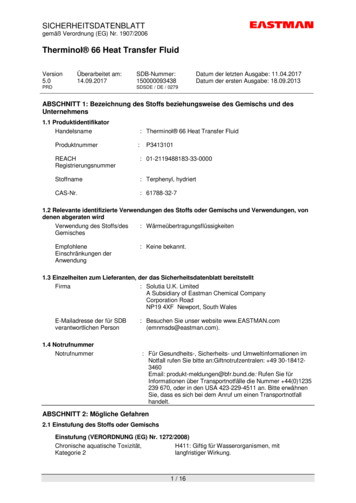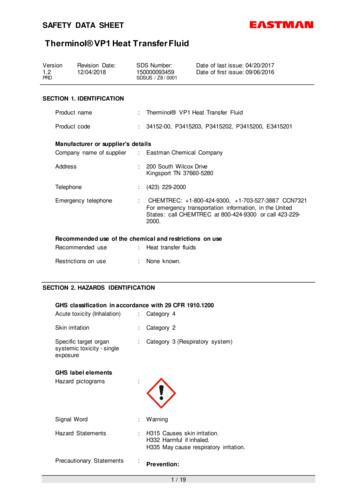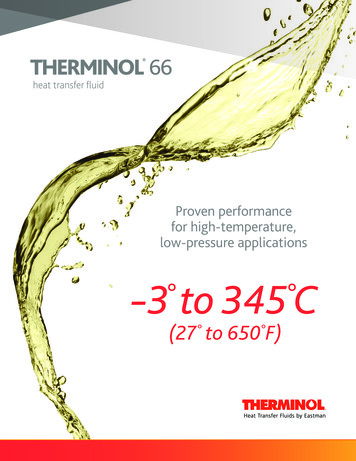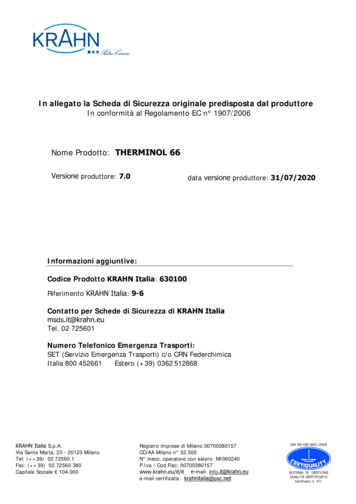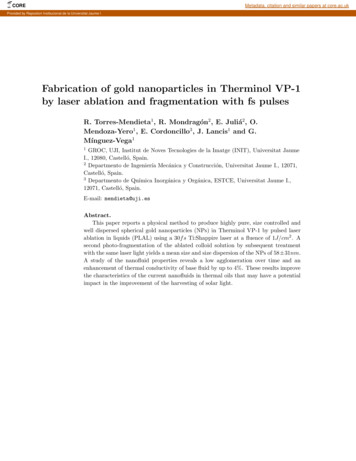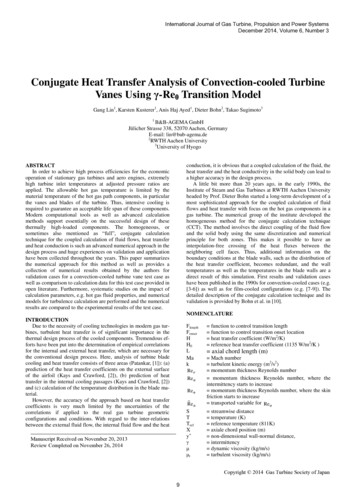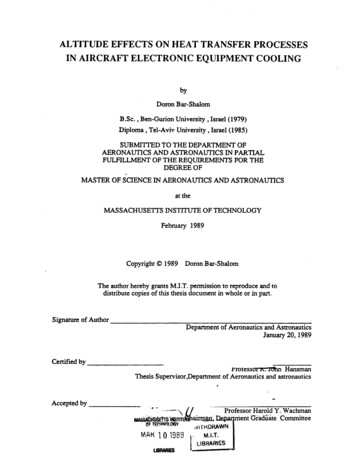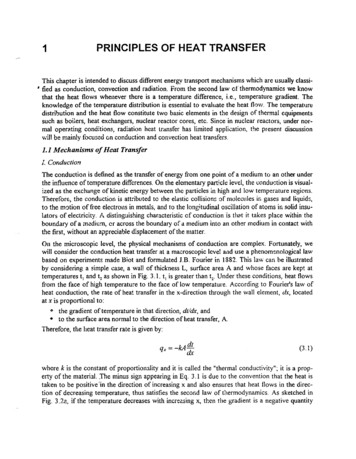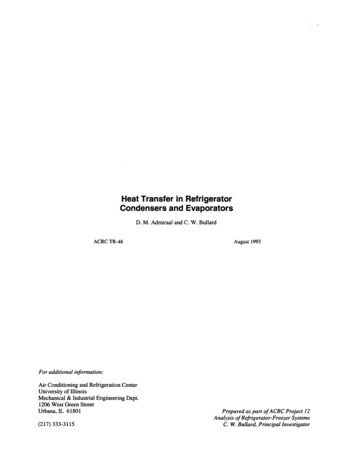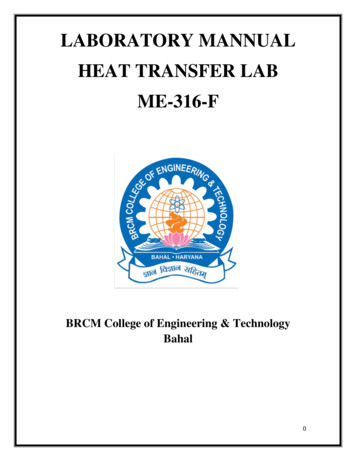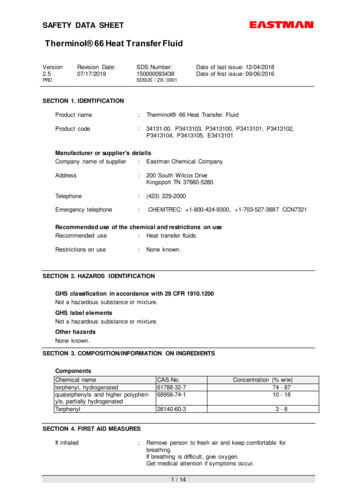
Transcription
SAFETY DATA SHEETTherminol 66 Heat Transfer FluidVersion2.5Revision Date:07/17/2019PRDSDS Number:150000093438Date of last issue: 12/04/2018Date of first issue: 09/06/2016SDSUS / Z8 / 0001SECTION 1. IDENTIFICATIONProduct name:Therminol 66 Heat Transfer FluidProduct code:34131-00, P3413103, P3413100, P3413101, P3413102,P3413104, P3413105, E3413101Manufacturer or supplier's detailsCompany name of supplier: Eastman Chemical CompanyAddress:200 South Wilcox DriveKingsport TN 37660-5280Telephone:(423) 229-2000Emergency telephone:CHEMTREC: 1-800-424-9300, 1-703-527-3887 CCN7321Recommended use of the chemical and restrictions on useRecommended use: Heat transfer fluidsRestrictions on use:None known.SECTION 2. HAZARDS IDENTIFICATIONGHS classification in accordance with 29 CFR 1910.1200Not a hazardous substance or mixture.GHS label elementsNot a hazardous substance or mixture.Other hazardsNone known.SECTION 3. COMPOSITION/INFORMATION ON INGREDIENTSComponentsChemical nameterphenyl, hydrogenatedquaterphenyls and higher polyphenyls, partially 140-60-3Concentration (% w/w)74 - 8710 - 183-8SECTION 4. FIRST AID MEASURESIf inhaled:Remove person to fresh air and keep comfortable forbreathing.If breathing is difficult, give oxygen.Get medical attention if symptoms occur.1 / 14
SAFETY DATA SHEETTherminol 66 Heat Transfer FluidVersion2.5Revision Date:07/17/2019PRDSDS Number:150000093438Date of last issue: 12/04/2018Date of first issue: 09/06/2016SDSUS / Z8 / 0001In case of skin contact:Wash off with soap and plenty of water.Get medical attention if symptoms occur.Wash contaminated clothing before reuse.In case of eye contact:In case of contact, immediately flush eyes with plenty of waterfor at least 15 minutes.Get medical attention if symptoms occur.If swallowed:Call a physician or poison control center immediately.Do NOT induce vomiting.Rinse mouth.Never give anything by mouth to an unconscious person.Most important symptomsand effects, both acute anddelayed:The molten product can cause serious burns.Notes to physician:Treat symptomatically.SECTION 5. FIRE-FIGHTING MEASURESSuitable extinguishing media:Water sprayCarbon dioxide (CO2)Dry chemicalFoamUnsuitable extinguishingmedia:Do not use a solid water stream as it may scatter and spreadfire.Hazardous combustion products:Hazardous decomposition products due to incompletecombustionCarbon oxidesFurther information:Use a water spray to cool fully closed containers.Do not allow run-off from fire fighting to enter drains or watercourses.Special protective equipmentfor fire-fighters:Wear an approved positive pressure self-contained breathingapparatus in addition to standard fire fighting gear.SECTION 6. ACCIDENTAL RELEASE MEASURESPersonal precautions, protec- :tive equipment and emergency proceduresVentilate the area.Avoid breathing dust/ fume/ gas/ mist/ vapors/ spray.Avoid contact with skin and eyes.Material can create slippery conditions.Wear appropriate personal protective equipment.Local authorities should be advised if significant spillagescannot be contained.Environmental precautionsClear up spills immediately and dispose of waste safely.:2 / 14
SAFETY DATA SHEETTherminol 66 Heat Transfer FluidVersion2.5Revision Date:07/17/2019PRDSDS Number:150000093438Date of last issue: 12/04/2018Date of first issue: 09/06/2016SDSUS / Z8 / 0001Avoid release to the environment.Methods and materials forcontainment and cleaning up:Contain spillage, soak up with non-combustible absorbentmaterial, (e.g. sand, earth, diatomaceous earth, vermiculite)and transfer to a container for disposal according to local /national regulations (see section 13).SECTION 7. HANDLING AND STORAGEAdvice on safe handling:Do not breathe vapors or spray mist.Handle product only in closed system or provide appropriateexhaust ventilation at machinery.In case of insufficient ventilation, wear suitable respiratoryequipment.Keep away from flames and sparks.Wear appropriate personal protective equipment.Avoid contact with skin, eyes and clothing.Wash thoroughly after handling.Wash contaminated clothing before reuse.Drain or remove substance from equipment prior to break-inor maintenance.Handle in accordance with good industrial hygiene and safetypractice.Conditions for safe storage:Keep container tightly closed in a dry and well-ventilatedplace.Keep in a cool place away from oxidizing agents.SECTION 8. EXPOSURE CONTROLS/PERSONAL PROTECTIONIngredients with workplace control parametersComponentsCAS-No.terphenyl, hydrogenated61788-32-7Value type(Form ofexposure)TWATWATWAEngineering measures:Control parameters / Permissibleconcentration0.5 ppm0.5 ppm5 mg/m30.5 ppm5 mg/m3BasisACGIHNIOSH RELOSHA P0Good general ventilation (typically 10 air changes per hour)should be used. Ventilation rates should be matched toconditions. If applicable, use process enclosures, localexhaust ventilation, or other engineering controls to maintainairborne levels below recommended exposure limits. Ifexposure limits have not been established, maintain airbornelevels to an acceptable level.Personal protective equipmentRespiratory protection: Use a properly fitted, particulate filter respirator complyingwith an approved standard if a risk assessment indicates this3 / 14
SAFETY DATA SHEETTherminol 66 Heat Transfer FluidVersion2.5Revision Date:07/17/2019PRDSDS Number:150000093438Date of last issue: 12/04/2018Date of first issue: 09/06/2016SDSUS / Z8 / 0001is necessary.Respirator selection, use, and maintenance must be inaccordance with regulatory requirements, if applicable.If engineering controls do not maintain airborneconcentrations below recommended exposure limits (whereapplicable) or to an acceptable level (in countries whereexposure limits have not been established), an approvedrespirator must be worn.Hand protectionRemarks:Wear suitable gloves. When handling hot material, use heatresistant gloves.Eye protection:Wear safety glasses with side shields (or goggles).Skin and body protection:Wear suitable protective clothing.Protective measures:Ensure that eye flushing systems and safety showers arelocated close to the working place.SECTION 9. PHYSICAL AND CHEMICAL PROPERTIESAppearance:liquidColor:colorless, light yellowOdor:characteristicOdor Threshold:not determinedpH:not determinedMelting point/range: -11 F / -24 C(1,013 hPa)Boiling point/boiling range:678 F / 359 C(1,013 hPa)Flash point:338 F / 170 CMethod: Pensky-Martens closed cup363 F / 184 CMethod: Cleveland open cupEvaporation rate:not determinedSelf-ignition:705 F / 374 C1,013 hPaMethod: ASTM E6594 / 14
SAFETY DATA SHEETTherminol 66 Heat Transfer FluidVersion2.5Revision Date:07/17/2019PRDSDS Number:150000093438Date of last issue: 12/04/2018Date of first issue: 09/06/2016SDSUS / Z8 / 0001Upper explosion limit / Upperflammability limit:not determinedLower explosion limit / Lowerflammability limit:not determinedVapor pressure:0.00174 hPa (68 F / 20 C)Relative vapor density:not determinedRelative density:1.013 (68 F / 20 C)Solubility(ies)Water solubility:0.061 mg/l (68 F / 20 C)Partition coefficient: noctanol/water:No data availableAutoignition temperature:not determinedDecomposition temperature:not determinedViscosityViscosity, dynamic:not determined:133 mm2/s (68 F / 20 C)Viscosity, kinematic29.6 mm2/s (104 F / 40 C)3.8 mm2/s (212 F / 100 C)Explosive properties:Not classifiedOxidizing properties:Not classifiedSECTION 10. STABILITY AND REACTIVITYReactivity:None reasonably foreseeable.Chemical stability:Stable under normal conditions.Possibility of hazardous reactions:None known.Conditions to avoid:Heating in air.Keep away from flames and sparks.Incompatible materials:Strong oxidizing agentsHazardous decompositionproducts:Emits acrid smoke and fumes when heated to decomposition.5 / 14
SAFETY DATA SHEETTherminol 66 Heat Transfer FluidVersion2.5Revision Date:07/17/2019PRDSDS Number:150000093438Date of last issue: 12/04/2018Date of first issue: 09/06/2016SDSUS / Z8 / 0001SECTION 11. TOXICOLOGICAL INFORMATIONAcute toxicityNot classified based on available information.Product:Acute oral toxicity:Remarks: No data availableAcute inhalation toxicity:Remarks: No data availableAcute dermal toxicity:Remarks: No data availableterphenyl, hydrogenated:Acute oral toxicity:LD50 Oral (Rat): 10,000 mg/kgAcute dermal toxicity:LD50 Dermal (Rabbit): 2,000 mg/kgAssessment: The substance or mixture has no acute dermaltoxicityComponents:Skin corrosion/irritationNot classified based on available information.Product:Remarks:No data available:::Rabbit24 hnoneComponents:terphenyl, hydrogenated:SpeciesExposure timeResultSerious eye damage/eye irritationNot classified based on available information.Product:Remarks:No data available:::Rabbitnone24 hComponents:terphenyl, hydrogenated:SpeciesResultExposure time6 / 14
SAFETY DATA SHEETTherminol 66 Heat Transfer FluidVersion2.5Revision Date:07/17/2019PRDSDS Number:150000093438Date of last issue: 12/04/2018Date of first issue: 09/06/2016SDSUS / Z8 / 0001Respiratory or skin sensitizationSkin sensitizationNot classified based on available information.Respiratory sensitizationNot classified based on available information.Product:Remarks:No data available::HumansNot a skin sensitizer.Components:terphenyl, hydrogenated:SpeciesResultGerm cell mutagenicityNot classified based on available information.Components:terphenyl, hydrogenated:Genotoxicity in vitro:Test Type: Mutagenicity - BacterialMethod: Bacterial Reverse Mutation AssayResult: negativeTest Type: Chromosome aberration test in vitroMethod: In vitro Mammalian Cell Gene Mutation TestResult: negativeTest Type: Mutagenicity - MammalianResult: negativeGenotoxicity in vivo:Species: RatMethod: Mammalian Bone Marrow Chromosome AberrationTestResult: negativeCarcinogenicityNot classified based on available information.Product:SpeciesApplication RouteRemarks:::Mouse, Male and FemaleDermalNot classifiedIARCNo ingredient of this product present at levels greater than or equal to 0.1% isidentified as probable, possible or confirmed human carcinogen by IARC.OSHANo component of this product present at levels greater than or equal to 0.1% ison OSHA’s list of regulated carcinogens.7 / 14
SAFETY DATA SHEETTherminol 66 Heat Transfer FluidVersion2.5Revision Date:07/17/2019PRDSDS Number:150000093438Date of last issue: 12/04/2018Date of first issue: 09/06/2016SDSUS / Z8 / 0001NTPNo ingredient of this product present at levels greater than or equal to 0.1% isidentified as a known or anticipated carcinogen by NTP.Reproductive toxicityNot classified based on available information.Product:Effects on fertility:Remarks: No data availableSTOT-single exposureNot classified based on available information.Product:Remarks:No data availableSTOT-repeated exposureNot classified based on available information.Product:Remarks:No data availableSpeciesNOAELLOAELApplication RouteExposure time:::::Rat12 mg/kg120 mg/kgOral Study90 dSpeciesNOAELApplication Route:::Rabbit2,000 mg/kgDermalRepeated dose toxicityComponents:terphenyl, hydrogenated:Aspiration toxicityNot classified based on available information.Product:No data availableInformation on likely routes of exposureProduct:Inhalation:Remarks: None known.Skin contact:Remarks: None known.Eye contact:Remarks: None known.8 / 14
SAFETY DATA SHEETTherminol 66 Heat Transfer FluidVersion2.5Revision Date:07/17/2019PRDSDS Number:150000093438Date of last issue: 12/04/2018Date of first issue: 09/06/2016SDSUS / Z8 / 0001Ingestion:Remarks: None known.SECTION 12. ECOLOGICAL INFORMATIONEcotoxicityProduct:Toxicity to daphnia and otheraquatic invertebrates:EC50 (Daphnia magna (Water flea)): 1 mg/lExposure time: 48 hToxicity to algae/aquaticplants:EC50 (Pseudokirchneriella subcapitata (algae)): 56 mg/lExposure time: 96 hToxicity to daphnia and otheraquatic invertebrates (Chronic toxicity):NOELR (Daphnia magna (Water flea)): 1 mg/lEnd point: mortalityExposure time: 21 dMethod: OECD Test Guideline 211:LC50 (Oncorhynchus mykiss (rainbow trout)): 1,000 mg/lExposure time: 96 hRemarks: No toxicity at the limit of solubility.:NOELR (Daphnia magna (Water flea)): 1 mg/lEnd point: mortalityExposure time: 21 dMethod: OECD Test Guideline 211Components:terphenyl, hydrogenated:Toxicity to fishToxicity to daphnia and otheraquatic invertebrates (Chronic toxicity)Persistence and degradabilityComponents:terphenyl, hydrogenated:Biodegradability:Result: Partially biodegradable.:Bioconcentration factor (BCF): 700 - 5,200:log Pow: 6.5Bioaccumulative potentialComponents:terphenyl, hydrogenated:BioaccumulationPartition coefficient: noctanol/water9 / 14
SAFETY DATA SHEETTherminol 66 Heat Transfer FluidVersion2.5Revision Date:07/17/2019PRDSDS Number:150000093438Date of last issue: 12/04/2018Date of first issue: 09/06/2016SDSUS / Z8 / 0001Mobility in soilComponents:terphenyl, hydrogenated:Distribution among environmental compartments:log Koc: 5.5:This substance is considered to be very persistent and verybioaccumulating (vPvB).Other adverse effectsComponents:terphenyl, hydrogenated:Results of PBT and vPvBassessmentSECTION 13. DISPOSAL CONSIDERATIONSDisposal methodsWaste from residues:Dispose of in accordance with local regulations.Empty containers should be taken to an approved wastehandling site for recycling or disposal.This material when discarded may be a hazardous waste asthat term is defined by the Resource Conservation andRecovery Act (RCRA), 40 CFR 261.24, due to its toxicitycharacteristic. This material should be analyzed inaccordance with Method 1311 for the compound D018BENZENE.Consult 40 CFR 268.40 or appropriate local regulations forconcentration based standards.This product meets the criteria for a synthetic used oil underthe U.S. EPA Standards for the Management of Used Oil (40CFR 279). Those standards govern recycling and disposal inlieu of 40 CFR 260 -272 of the Federal hazardous wasteprogram in states that have adopted these used oilreg
Therminol 66 Heat Transfer Fluid Version 2.5 PRD Revision Date: 07/17/2019 SDS Number: 150000093438 SDSUS / Z8 / 0001 Date of last issue: 12/04/2018 Date of first
